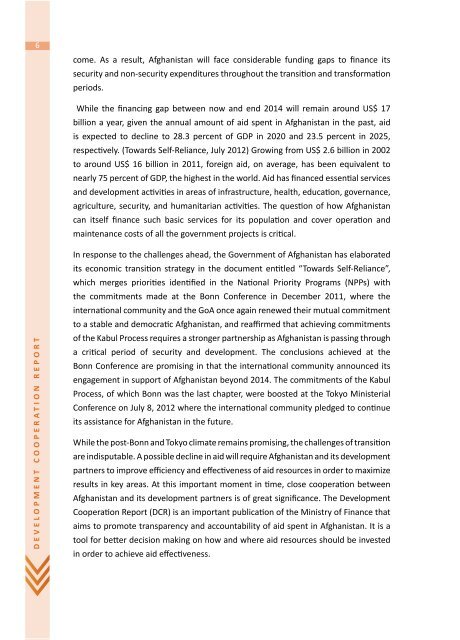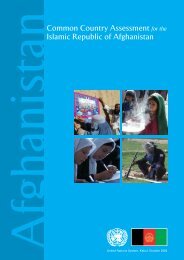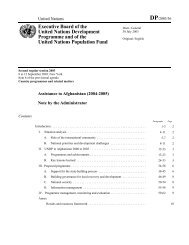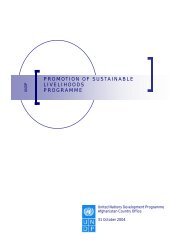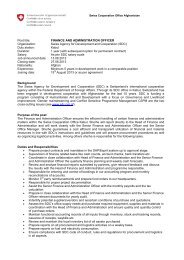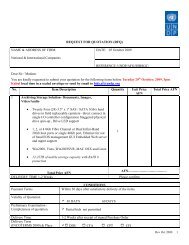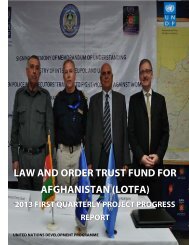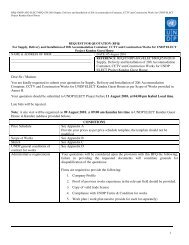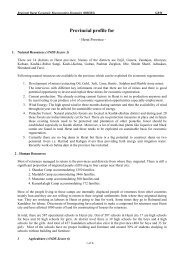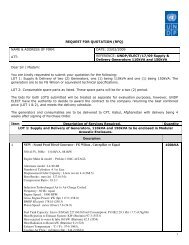Development Cooperation Report 2012 - UNDP Afghanistan
Development Cooperation Report 2012 - UNDP Afghanistan
Development Cooperation Report 2012 - UNDP Afghanistan
Create successful ePaper yourself
Turn your PDF publications into a flip-book with our unique Google optimized e-Paper software.
6<br />
come. As a result, <strong>Afghanistan</strong> will face considerable funding gaps to finance its<br />
security and non-security expenditures throughout the transition and transformation<br />
periods.<br />
While the financing gap between now and end 2014 will remain around US$ 17<br />
billion a year, given the annual amount of aid spent in <strong>Afghanistan</strong> in the past, aid<br />
is expected to decline to 28.3 percent of GDP in 2020 and 23.5 percent in 2025,<br />
respectively. (Towards Self-Reliance, July <strong>2012</strong>) Growing from US$ 2.6 billion in 2002<br />
to around US$ 16 billion in 2011, foreign aid, on average, has been equivalent to<br />
nearly 75 percent of GDP, the highest in the world. Aid has financed essential services<br />
and development activities in areas of infrastructure, health, education, governance,<br />
agriculture, security, and humanitarian activities. The question of how <strong>Afghanistan</strong><br />
can itself finance such basic services for its population and cover operation and<br />
maintenance costs of all the government projects is critical.<br />
DEVELOPMENT COOPERATION REPORT<br />
In response to the challenges ahead, the Government of <strong>Afghanistan</strong> has elaborated<br />
its economic transition strategy in the document entitled “Towards Self-Reliance”,<br />
which merges priorities identified in the National Priority Programs (NPPs) with<br />
the commitments made at the Bonn Conference in December 2011, where the<br />
international community and the GoA once again renewed their mutual commitment<br />
to a stable and democratic <strong>Afghanistan</strong>, and reaffirmed that achieving commitments<br />
of the Kabul Process requires a stronger partnership as <strong>Afghanistan</strong> is passing through<br />
a critical period of security and development. The conclusions achieved at the<br />
Bonn Conference are promising in that the international community announced its<br />
engagement in support of <strong>Afghanistan</strong> beyond 2014. The commitments of the Kabul<br />
Process, of which Bonn was the last chapter, were boosted at the Tokyo Ministerial<br />
Conference on July 8, <strong>2012</strong> where the international community pledged to continue<br />
its assistance for <strong>Afghanistan</strong> in the future.<br />
While the post-Bonn and Tokyo climate remains promising, the challenges of transition<br />
are indisputable. A possible decline in aid will require <strong>Afghanistan</strong> and its development<br />
partners to improve efficiency and effectiveness of aid resources in order to maximize<br />
results in key areas. At this important moment in time, close cooperation between<br />
<strong>Afghanistan</strong> and its development partners is of great significance. The <strong>Development</strong><br />
<strong>Cooperation</strong> <strong>Report</strong> (DCR) is an important publication of the Ministry of Finance that<br />
aims to promote transparency and accountability of aid spent in <strong>Afghanistan</strong>. It is a<br />
tool for better decision making on how and where aid resources should be invested<br />
in order to achieve aid effectiveness.


